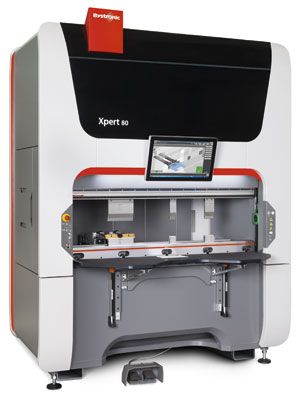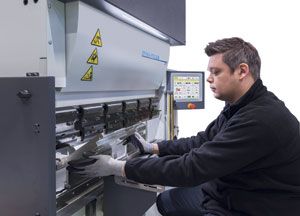by Noelle Stapinsky
Demand for smaller batch sizes is driving advancements in set up technology, operator interaction, and a shift towards smaller press brakes
As more fabricators move toward shorter runs and more complex bending geometries, the days of simply buying more press brakes to bend more parts are long gone. Now it’s all about smarter, faster, more sophisticated machines with better operator ergonomics. And there have been huge leaps in technology.
Press brakes are one of the few machines on the shop floor that require an operator to interact with a part. Setting up the tooling, doing test bends, and troubleshooting angle corrections, to name a few, are all time consuming.
 And with the introduction of faster fiber lasers and a lack of skilled operators entering the industry, the press brake has become a prime location for operation bottlenecks.
And with the introduction of faster fiber lasers and a lack of skilled operators entering the industry, the press brake has become a prime location for operation bottlenecks.
“The very real challenge for fabricators is small batches, short lead times, reduced stock inventory and more complex parts,” says Steven Lucas, press brake product manager, LVD Strippit. “Part of tackling this challenge is a bending process that can move quickly from the initial CAM to an accurate finished part that’s correctly formed from the first operation. The way we address this is largely through advances in software.”
A decade ago, it was next to impossible to get fabricators to program their press brakes offline. But today, nesting software, offline programming and more automated tooling setups have become the new reality.
“We sell offline software with about 90 per cent of our brakes now,” says Scott Ottens, bending product manager, Amada America Inc.
“If you go back five to ten years, the average press brake that everyone bought was around 90 tons and eight feet long. I’ve actually seen them get a little bigger. The real reason for that is not to bend longer parts, but more people are doing stage bending,” says Ottens.
 “You might have a part, for example, that has 12 bends. In the past, you’d have to set up three press brakes to bend that job. But with a longer press brake you can set up a stage bend along the length of the brake and one operator can bend a part complete.”
“You might have a part, for example, that has 12 bends. In the past, you’d have to set up three press brakes to bend that job. But with a longer press brake you can set up a stage bend along the length of the brake and one operator can bend a part complete.”
That said, such setups can be very complex and the distance between the stages is critical. “If you program that part offline, you’re given control and a lot of information about the part geometry. The software can create the setup for you,” says Ottens.
Smooth Operator
Offline programming also helps eliminate test bends or samples. “Having the right blank size is key to first part good part,” says Paul LeTang, press brake product manager, Bystronic Inc. “To guarantee that, you need a very thorough programming system that identifies any potential problems early in the process. It might seem a little backwards, but we recommend you make the bend program before you make the cutting program.”
Working in a virtual environment is certainly faster and it’s not wasting valuable time on the shop floor. “You’re sitting at a desk wasting a $1,000 asset (the computer), rather than standing at the machine wasting a $20,000 asset while you try to work through issues with a part,” says LeTang.
To make the press brake operator’s job easier and faster, the industry has developed solutions and technology to remedy processes that were once time consuming. Tooling has been more conveniently located closer to the machines. And there are programs that help with quicker setup times.
“Now, on the machines, when you call up a program it tells the operator what tools go where on the press. There are also lights that physically show him or her where to put those tools,” says LeTang.
Amada’s HG Series press brakes feature an automatic tool changer (ATC). There’s a stacker of tools in the side of the machine. “The operator just needs to pull up a program and stand back while the setup is being created for them,” says Ottens. “And when they bend there is a 3D view of how to bend the part on the control form. So they can see ‘oh I have to gauge it on this stage, this way.’ If they can look at a screen, they can bend the part.”
Lucas says that LVD is focused on the big picture to improve efficiencies and productivity through integrated software. LVD’s Easy-Form Laser adaptive bending system is an in-process angle monitoring and correction system that adapts the ram position in real time to get the right bend angle the first time.
“What we’re seeing with our larger, more sophisticated press brakes is that customers are opting to add devices like sheet followers to handle larger parts more easily,” says Lucas. “But in general, there is more of a focus on improving efficiency and productivity of small to medium runs.”
While most fabricators are still doing large bends, about 80 per cent of the parts are 40 inches or less. On a typical press brake, if you look at the ram and bed, there are vertical components straight up and down from the tool set making it difficult for the operator to get close to the bending area. “The trend today is to put cutouts in the lower upright, so the operator can actually sit down in front of the machine and put his legs under the bending zone,” says LeTang.
Smaller brakes, Faster results
In the past, buying a big machine was the biggest bang for your buck. But as more fabricators experience bottlenecks trying to process small parts on big machines, the benefits of a smaller press brakes are being noticed. “Small parts are easily processed on those machines, they take the load off the big brakes, and operators are bending those parts maybe two or three times faster,” says LeTang.
Interestingly, portable press brakes are starting to trend. Lucas agrees. “If you’re consistently bending small parts, a small electric press brake is a good choice. They offer high-speed bending, are energy efficient, portable and come at a lower level of investment. And they can be used standing or sitting down, providing good ergonomics for the operator.”
When fabricators are dealing with large runs or parts, transporting them to and from the press brake with a forklift made sense. But when it’s just five parts, for example, the material handling is essentially the same as the larger lot sizes. “One of the phenomena today is being able to move the machines around based on where the constraints are in manufacturing,” says LeTang.
It’s common on fiber lasers or the turret punch to manually unload the machine due to the shape and nature of the part. LeTang says, “why not put the press brake next to the laser. The operator can pull the part out of the skeleton, bend it, drop it in the bin and it’s done.”
The footprint of Bystronic’s Xpert 40 and 80 portable press brakes has been manipulated—they’re only slightly larger than a standard pallet—with the electrical cabinet moved to the back of the machine. And the controller is pendant mounted on the front of the machine where the operator stands. There are also cabinets for manuals, press brake tooling, and slots for paperwork. “You can pick it up with a forklift and move it from one area to another,” says LeTang. “Our machines are completely self-contained… there’s even a cabinet you can put your lunch in.”
For press brake manufacturers, smaller brakes and electric brakes are becoming a more important part of the bending solutions portfolio. Lucas says, “They answer a need for those shops bending more small to medium batches. But the demand for more sophisticated and flexible machines to handle more challenging bending operations is not shrinking. We’ve had considerable interest in our large-profile bending press brakes. We see the need at both ends of the spectrum.” SMT
